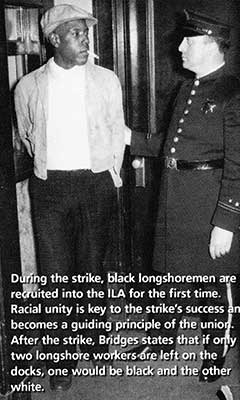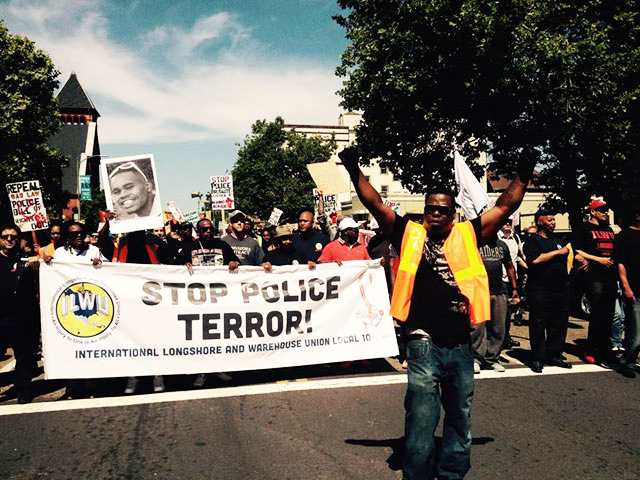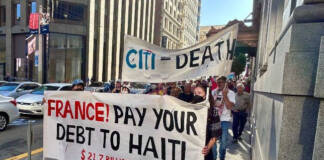
by Peter Cole
From its inception in the 1930s, the International Longshore and Warehouse Union (ILWU), and particularly its San Francisco Bay Area chapter, Local 10, have preached and practiced racial equality. First, the union committed itself to equality by desegregating work gangs and opening its ranks to African Americans, whose numbers drastically increased during the World War II-induced Great Migration.
In addition to working towards racial equality inside the ILWU, longshoremen and their leaders, in Local 10 and at the international level, participated in myriad intersectional social movements from the 1940s to the present. Thanks to this organizing, longshore workers and their union greatly contributed to the growth and success of social movements in a pivotal time in Bay Area, U.S. and world history.
An early, poignant example of the union’s commitment to ethnic and racial equality came in its principled yet highly controversial opposition to the persecution of Japanese Americans during World War II. In 1942 the ILWU condemned the interment of 125,000 Japanese and Japanese Americans, ordered by President Franklin D. Roosevelt shortly after the surprise Japanese attack on the U.S. naval base at Pearl Harbor, Hawai’i.
Hostility towards Japanese immigrants – by law, never allowed to become U.S. citizens – and Japanese Americans quickly reached fever pitch, and almost no Americans came to their defense; though, more recently, most acknowledge the trampling of their Constitutional rights. Yet in sworn testimony before Congress in February 1942, only three months after Pearl Harbor, ILWU leader Lou Goldblatt sagely predicted, “This entire episode of hysteria and mob chant against the native-born Japanese will form a dark page of American history. It may well appear as one of the victories by the Axis powers.”
Similarly, in May 1945, the month Germany surrendered and three months before Japan did, ILWU International President Harry Bridges pushed to have a few Japanese Americans, interned for most of the war, admitted to the Stockton division of Local 6 (Bay Area warehouse) in conjunction with the government’s War Relocation Authority.
When the white majority division refused to allow them into the union, Bridges and Goldblatt pulled the charter until the 700 members accepted this Japanese American into the local. The union’s commitment to equality for Japanese Americans was rare, to say the least, and remains largely unknown.
The ILWU has also been committed to and fought for racial equality since its birth in the 1930s. This sort of activism, still all too rare, is called civil rights unionism or social movement unionism. Examples of how the ILWU worked in solidarity with the largely Southern-based Black freedom struggle are too numerous to recount, but the union’s commitment was real and long-standing.
Bridges regularly wrote in favor of racial equality in his column “On the Beam” that appeared in the union’s newspaper, Dispatcher. In 1954 after the U.S. Supreme Court issued its historic ruling against Jim Crow segregation in Brown v. Board of Education, Bridges lauded it as “a victory for all decent and progressive Americans – whether Negro, white or any other color,” because the Jim Crow “system has been a cancer on America.”
In 1963, the ILWU began selling units in the housing cooperative that its progressive leaders conceived of and financed as a response to “urban redevelopment” and a lack of affordable housing. Though not the first of its kind (several clothing worker unions in New York City constructed thousands of such units), the St. Francis Square Housing Cooperative was the Bay Area’s first.
Beginning in 1960, the ILWU invested some of its pension funds into property that had been part of a 45-block area cleared, notoriously, by city and federal housing agencies in a move criticized by the legendary African American writer and activist James Baldwin: “Urban renewal which means moving Negroes out; it means Negro removal.” The “redevelopment” of the Fillmore (also called the Western Addition), the city’s largest Black neighborhood, begun in the 1950s and continued into the early 1970s, razed about 2,500 Victorian structures and displaced more than 10,000 people – overwhelmingly African Americans including hundreds of ILWU Local 6 and 10 members.
ILWU Secretary-Treasurer Lou Goldblatt explained why he developed this project in 1979: “What they were not doing was replacing the slums with anything that any of the people who had lived there could have any chance under the sun of coming back to.” St. Francis’ 300 units were open to every ethnicity and race, the first integrated housing development in San Francisco, and its first manager was Revels Cayton, a Black left-wing activist and ILWU member.

ILWU members who lived in the Fillmore continued resisting further clearings, albeit with limited success. Ultimately, the character of the Fillmore changed forever with far fewer Blacks. The co-op, though, recently celebrated its 50th anniversary.
Also in 1963, the ILWU and Local 10 helped organize a huge civil rights demonstration in San Francisco and supported another, the legendary March on Washington for Jobs and Freedom. Early that year, the nation’s eyes focused upon Birmingham, Alabama, nicknamed “America’s Johannesburg” for being the most segregated big city in the South.
The Southern Christian Leadership Conference, headed by Martin Luther King Jr., collaborated with local activists for several months of nonviolent civil disobedience to highlight the persistence of racial segregation, nearly 10 years after Brown v. Board. Chester, utilizing his many contacts, helped create the Church-Labor Conference that, on May 26, brought together 20,000 people to march with a giant banner reading “We March in Unity for Freedom in Birmingham and Equality in San Francisco.”
An additional 10,000 joined at the march’s end to rally, and was the largest civil rights demonstration in the region’s history. Three months later, the ILWU donated money and sent a delegation to the nation’s capital for what proved to be the largest political gathering in U.S. history, up to that time.
One quarter of a million Americans, mostly Black but with many whites, participated in the March on Washington to pressure the Congress and president to pass a comprehensive civil rights bill outlawing racial discrimination once and for all. Tragically, the response of some unreconstructed segregationists was the blowing up of a Black church in Birmingham, closely associated with the movement, that killed four Black girls.
When word reached San Francisco, Local 10 members quickly shut down the port for a “stop work meeting” in front of the U.S. Federal Building to protest this terrorist attack.
Due to the union’s many efforts to fight racism, in 1967 Martin Luther King Jr. visited Local 10, where he became an honorary member, like Paul Robeson before him. King, best known for his “I Have a Dream” speech, long had been interested in and supportive of unions but proved increasingly so in his final years. He repeatedly encouraged Black workers to join and form unions, famously calling them “the first anti-poverty program.”
Legendary African American activist Bayard Rustin wrote, “The Negro can never be socially and politically free until he is economically secure.” Rustin could have been describing the civil rights unionism of ILWU Local 10.
King regularly supported and spoke to racially inclusive unions, so it not surprising that he visited Local 10’s hiring hall. Addressing a large gathering of dockworkers, King declared, “I don’t feel like a stranger here in the midst of the ILWU. We have been strengthened and energized by the support you have given to our struggles …We’ve learned from labor the meaning of power.”
More than 40 years later, Local 10 member Cleophas Williams remembered the speech: “He talked about the economics of discrimination,” insightfully pointing out, “What he said is what Bridges had been saying all along” about all workers benefiting by attacking racism and forming interracial unions.
The day after his stunning murder on April 4, 1968, the Bay Area was quiet while more than 150 cities and towns erupted into flames. Longshoremen shut down the ports of San Francisco and Oakland for their newest (honorary) member, as they always do when one of their own dies on the job. Nine ILWU members attended King’s funeral in Atlanta, including Bridges, Chester and Williams, elected the local’s first Black president the year prior.
Similarly, it is neither incidental nor coincidental that ILWU members in the Bay Area gave timely and significant support to Californians seeking to form the United Farm Workers (UFW). It is widely known that migratory farm workers were heavily non-white – particularly Mexican and Filipino Americans – and immigrant, most Mexican but also smatterings of other peoples including Arabs.
When Filipino American farm workers struck large table and wine grape growers in and around Delano, California, in 1965, they quickly joined forces with Cesar Chavez’s fledgling union of mostly Mexican Americans. Thus began a five-year saga that – like the predominantly African American sanitation workers with their “I Am A Man” campaign – combined elements of labor and civil rights activism.
On Nov. 17, 1965, a few of these strikers stood at the foot of San Francisco’s Pier 50, hoping to convince longshoremen not to load Delano grapes aboard the President Wilson, headed for Asia. One key activist, Gilbert Padilla, described what happened next:
“We went there as the grapes were being loaded onto ships to Japan … and I’m standing out there with a little cardboard, with a picket sign, ‘Don’t eat grapes.’ Then some of the longshoremen asked, ‘Is this a labor dispute?’ And I [was nervous and didn’t know whether we were legally allowed to use the term, so I] said, ‘No, no, no labor dispute.’ So they would walk in.
“Jimmy Herman came over and asked me, ‘What the hell you doing?’ And I told him we were striking. He knew about the strike but wanted to know, ‘What are you asking for?’ And I was telling him, and then he says, ‘Come with me.’
“He took me to his office; he was president of the clerks (a Longshoremen’s Union local). He took me to his office and he got on his hands and knees, Jimmy Herman, and he made picket signs. And he told me, ‘You go back there and don’t tell nobody about who gave you this. But you just stand there. [You] don’t [have to] say a goddamned thing.’
“The sign said, ‘Farm Workers on Strike.’ And everybody walked out of that fucking place, man! That’s the first time I felt like I was 10 feet tall, man! Everybody walked out. So then they asked what’s happening and we were telling them, and, Jesus Christ, man, I never seen anything like it. There were trucks all the way up to the bridge, man!”
That Bay Area longshoremen and clerks actively supported this movement comes as little surprise, especially as the ILWU organized farm workers, overwhelmingly Asian Americans, in Hawai’i in the 1950s.
Local 10 also played an integral, if hidden, role in the historic Pan-Indian occupation of Alcatraz, one of the most incredible chapters in Bay Area social movement history. Beginning in 1969, American Indians, including many students at San Francisco State, planned and occupied the legendary Alcatraz Island, a former federal penitentiary. They did so to raise awareness of the desperate plight of American Indians and promote cultural and political changes among both Indians and the nation at large.
Long forgotten or never known is that a Local 10 longshoreman, “Indian Joe” Morris, born and raised on the Blackfoot reservation in Montana, helped make the 18-month occupation possible. The 12-acre “Rock” was lifeless, so literally everything needed to sustain the occupiers’ lives, including water, had to come from the mainland – a main reason the federal government stopped using it as a prison.
Morris secured the unused SF Pier 40 from which the transfer of all people and supplies occurred between the island and city. In his unpublished memoir, he writes, “When the Indians occupied Alcatraz Island, I was the Alcatraz troubleshooter and mainland coordinator.”
Morris also raised thousands of dollars from the ILWU and other unions in support and even took collections at the Ferry Building (now named after Harry Bridges). Without Morris’ unsung action, the occupation – simply put – could not have continued very long.
Morris might have been the only American Indian in Local 10, but there was tremendous sympathy among others for the occupation; for example, the ILWU Executive Board praised the Indians occupying Alcatraz “as a haven and a symbol of the genocide they have suffered.” Morris helped arrange for a delegation of Local 10 and other ILWU members to visit Alcatraz, where Lou Goldblatt proclaimed: “You folks are just like a labor union on strike. You have to last one day longer than the other guy.” Winding down in 1971, the Dispatcher featured a photograph of Morris holding a painting – his first ever – commemorating the occupation, though few know this intersectional history.
In 1969, the legendary African American activist Bayard Rustin wrote, “The Negro can never be socially and politically free until he is economically secure.” Rustin could have been describing the civil rights unionism of ILWU Local 10.
Or, as William “Bill” Chester, an African American and long-time civil rights activist in the ILWU, recalled, “We found that, in a sense, the union is the community.” Bay Area longshore workers did not stop with racial equality, though. They also provided mighty assistance to many other social movements across the Bay Area, nation and world.
Peter Cole is a professor of history at Western Illinois University. He is the author of “Wobblies on the Waterfront: Interracial Unionism in Progressive Era Philadelphia” and is currently at work on a book entitled “Dockworker Power: Race and Activism in Durban and the San Francisco Bay Area.” He is a research associate in the Society, Work and Development Program (SWOP) at the University of the Witwatersrand in Johannesburg, South Africa, and has published extensively on labor history and politics. He tweets from @ProfPeterCole. This story is reprinted with permission from In These Times, where it first appeared.
Note from In These Times: This article is adapted from “Dockworker Power: Race and Activism in Durban and the San Francisco Bay Area.” Used with the permission of the University of Illinois Press. Copyright © 2018 by the Board of Trustees of the University of Illinois. It has been modified for this article, with the introductions and conclusions reworked.





